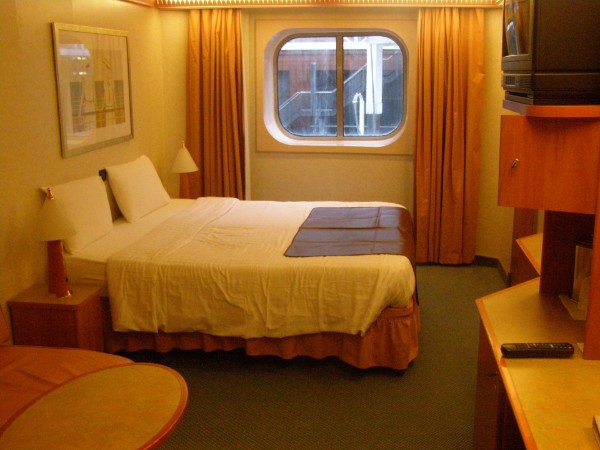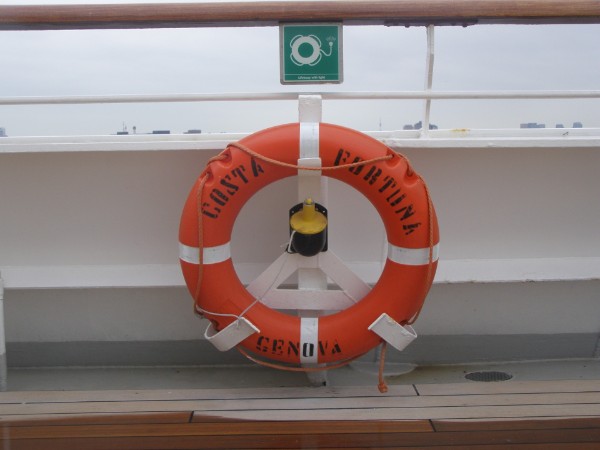
Costa Fortuna is a tribute to the great Italian oceanliners that sailed the oceans from the 1920's untill the 1970's, before cruiselines like Costa took over the trades. Costa itself has its origins in the passengerlines from Italy to mostly South America and of course, Costa Lines is not forgotten in the ships interiour decorations. The decor of the ship overall is a superb blend between the oceanliners of yesteryear and the modern Farcassian architecture. One of the most striking spaces aboard is certainly the Atrio Costa, where the line itself is the most visable inspiration.
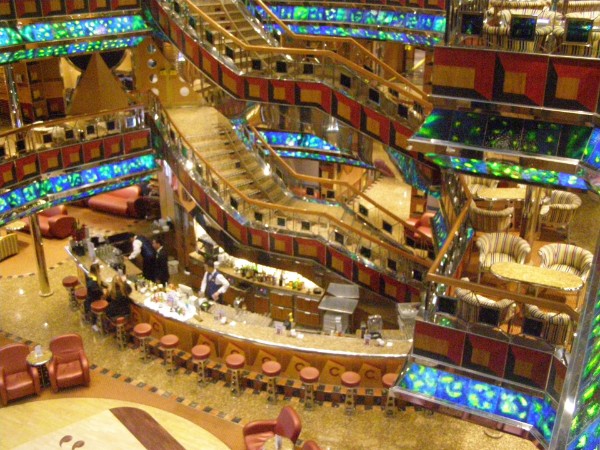
Of course the bar at Buenos Aires Deck (3) is one of the central hubs of the ship where you see and are being seen. But the most striking decoration is the roof, where all Costa passangerships from Anna C. untill Costa Fortuna are dangling upside down, defying gravity. The line had many more ships, but only the ones that carried passengers are shown. When you move up with one of the four glass elevators at the atrium to Cannes Deck (11), you'll also pass a large mural where again all passenger carri-ing ships of Costa are featured. Of course, in both works of art, shown below, Costa Fortuna herself is the main character.
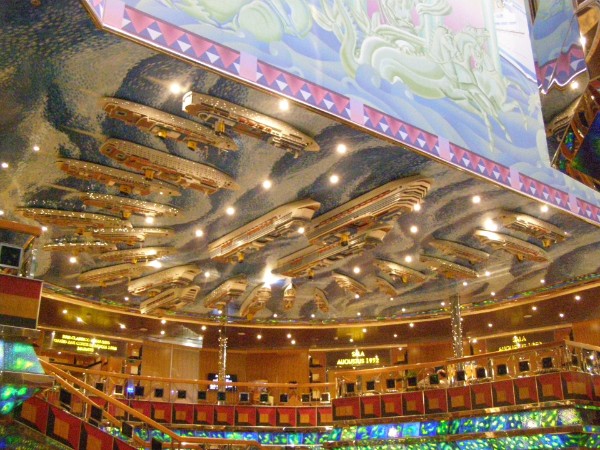
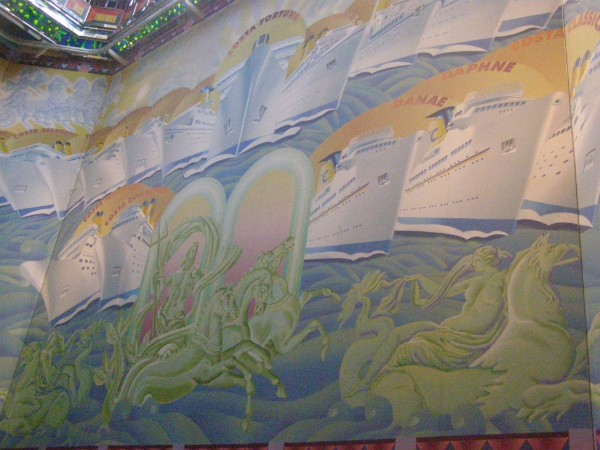
Furthemore, the most well-known Italian liners in history all have their own space and the largest ships also have the largest spaces. Of course, the designers cannot go without the grandest of them all, Rex. So the largest space aboard, the theater, is named Teatro Rex 1932 and the stage is flanked by two bows re-presenting the great ship herself. Also at the entrances to the Teatro, the ship is displayed in nautical settings on the walls and throughout her funnelcolours of the Italia Line are visible. The theater spans three decks and is located close forward to the Atrio over decks 3, 4 and 5.
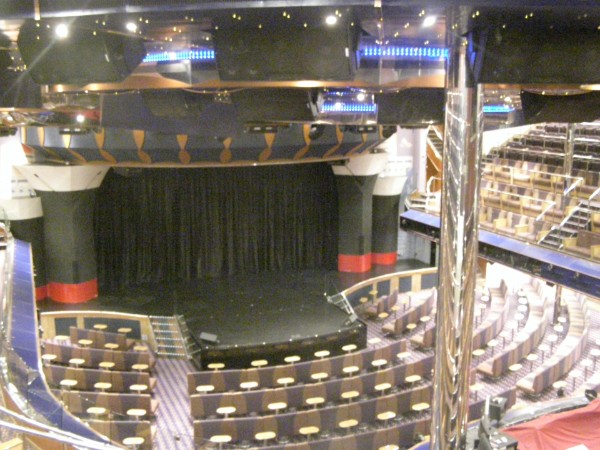
Her sistership Conte Di Savoia also has a large space named after her, the Grand Bar Conte Di Savoia 1932 midships at Genoa Deck (5). The original ship had been ordered by Lloyd Sabaudo at the end of the 1920's, but when she was delivered, she also sailed for Italia Line because Lloyd Sabaudo and Navigazione Generae Italiana, the owners of Rex, had merged while she was built. Both ships really looked alike, but had several differences in interiour and exteriour. Mostly, Rex is considered the more beautifull one because she was more strealined. But both of them really brought Italy in the forefront of the liner trades, next to the French, the Germans and the Brits.The Grand Bar is shown below.
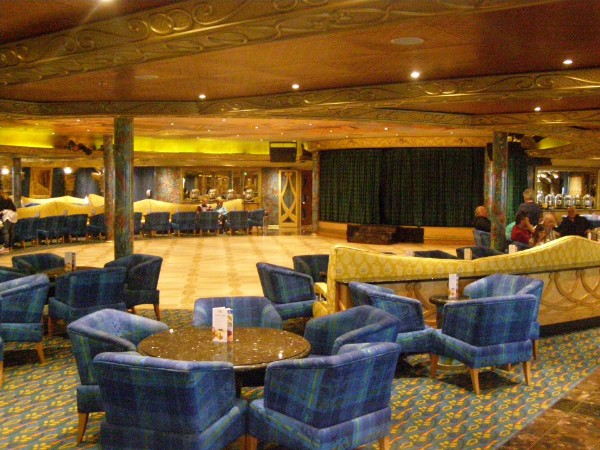
Sadly, both ships Rex and Conte Di Savoia were war casualties in the 1940's and with Italy ruined after its defeat in 1945, it took a long while untill the country was able to built a new pair of oceangiants. In Costa Fortuna, those two are the name-givers to the two main restaurants aboard. Midships at deck 3 and 4 is the Ristorante Raffaelo 1965 and at the stern on the same two decks is the Ristorante Michelangelo 1965. Both restaurants are very similar in appearance, with the Ristorante Michelangelo being the larger of the two. In their day, Raffaelo was the slightly larger ship, though. They were the largest Italian liners since the duo from the 1930's and were built only for national prestige and heavily subsidized by the Italian government because they never earned money for their owners. The last major Italian Atlantic liners only sailed untill 1975 for the Italia Line because of the changed world they were in and none of the two seemed suitable for cruising. Both ships were sold to the Iranian government in 1976. Raffaelo was sadly torpedoed during the Iran-Iraqui war in 1983. She was partially dismantled, but her remains are now still marked by warning buoys. There had been several scemes to put Michelangelo back in service as an Iranian cruiseliner, but nothing came of that and she was finally scrapped in Pakistan in 1991. A huge 1965-built model of Michelangelo is now in front of her restaurant aboard Costa Fortuna, reminding passengers of our time where todays cruiseships are originally related to. Below, her model is shown, then her restaurant, followed by the Ristorante Raffaelo 1965.
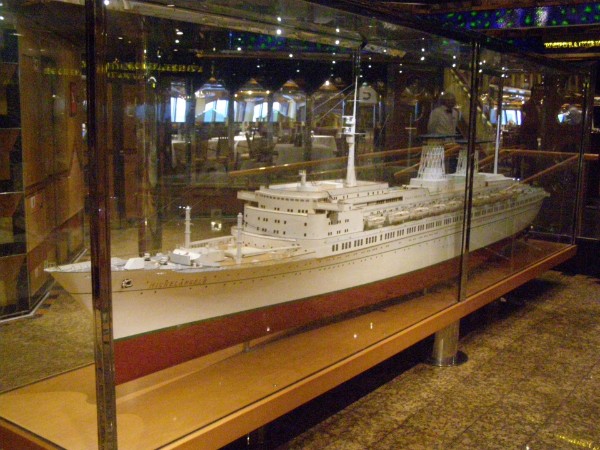
The 1965-model of Michelangelo and a centerpiece in the ships art-collection.
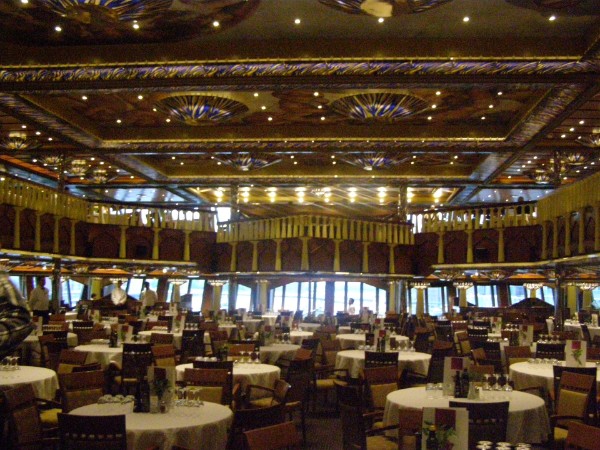
Ristorante Michelangelo 1965 above and Ristorante Raffaelo 1965 below.
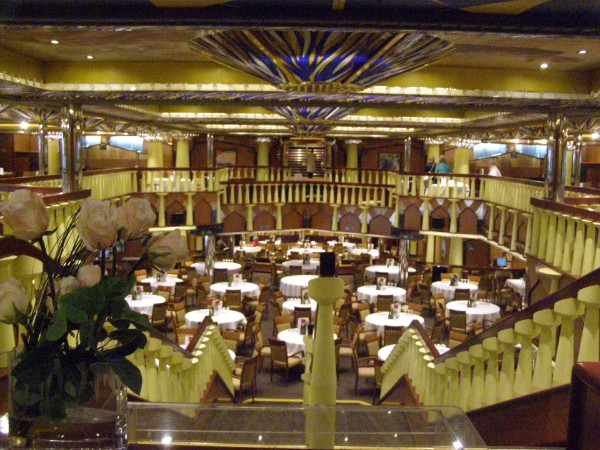
The Italian Line had launched a ship before the 1965-duo and she was the Leonardo Da Vinci from 1960. She is also remembered at Costa Fortuna and given the large lounge at the stern of Genoa Deck (5). Her lounge has many seats and a stage where smaller performances are presented then in the Teatro Rex 1932. Leonardo Da Vinci was built as a replacement for the Andrea Doria, that had sank in 1956 in mid-Atlantic after she collided with the Swedish liner Stockholm. The latter one is now still sailing as Azores for the British-based CMV Cruises and also present at Castles Of The Seas. Below is the Salone Leonardo Da Vinci 1960. At its walls, paintings by Da Vinci are shown.
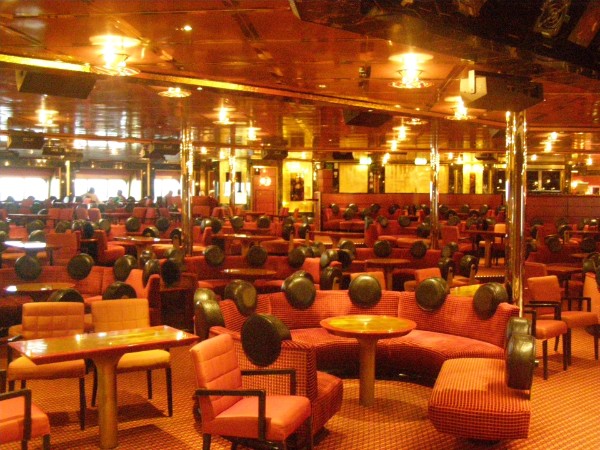
Another casualty of the second worldwar was the Neptunia, originally built in 1932. On Costa Fortuna, she is remembered in the Casino Neptunia 1932. The ship was torpedoed by the British submarine HMS Upholder at the 18th of september 1941, together with her sister Oceania. Both ships from the Italia Line went under close to Tripoli and are now major wreckdiving sites. The ships sank with a reported loss of life of 5000 soldiers during trooping voyages to northern Africa. The number is debated, more likely it is 'just' 500. All in all, to some it might seem strange that a major cruiseline like Costa is naming lounges aboard one of their cruiseliners to ships that worked for Mussolini's fascist Italy in the 1940's. I respect and undestand people who might think it is a little awkward and maybe even unwanted, but Costa is remembering the great ships and not their war-efforts. Besides, none of those ships was built for war, they were only built for crossings between nations to bring people together. Those ships were used for war, but the problem in that is not the ships themselves but the Italian fascist movement in those years. Italy has this sad history, but the country has to live with it and in my opinion, Italy and also Germany have continued and the cruelties of war have now to be remembered in its good and bad versions to learn from the mistakes made. From one of my favorite artists Heather Nova, the song 'Every Soldier Is A Mothers Son' reflects this opinion that soldiers on both sides of conflicts are all victims, and the same counts for ships. Enough about that, below is the Casino Neptunia 1932.
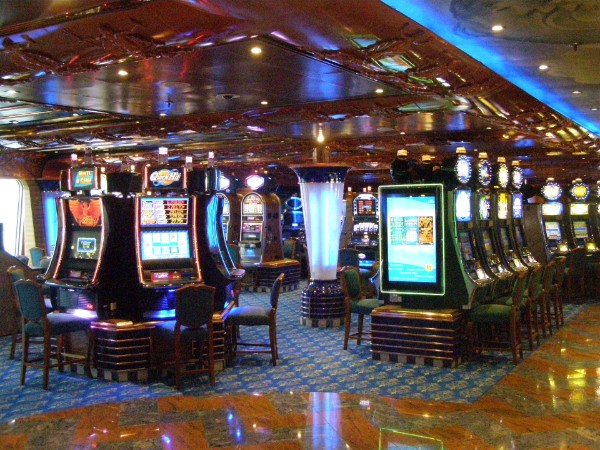
As we are still at Genova Deck (5), we can also take a look in several smaller spaces here. Just next to the entrance to the Salone Leonardo Da Vinci 1960, are the Piano Bar Conte Rosso 1921 at the starboard side and the Sala de Ballo Conte Verde 1923 at the port side, the oldest ships that have rooms aboard Costa Fortuna. Both Conte Verde and Conte Rosso, sisters, were built for Lloyd Sabaudo. Both again were war casualties during te 1940's, Co-incidently, Conte Rosso was torpedoed by the same submarine that ended the carreers of Neptunia and Oceania, HMS Upholder, at the 24th of may 1941 close to the island of Sicily. Maybe Costa Cruises' British sistercompanies Cunard Line or P&O can name a lounge after that one submarine to get even with the Italians at Costa. I show pictures of both lounges below and you have to guess which is which (think about the colours..!).
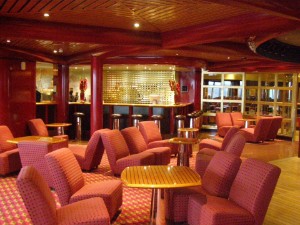 | | 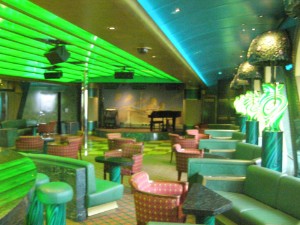 |
| | |
Just before we get back to the Atrio Costa, the Sala Carte is at starboard (there was no ship left to name that one after) and at port there is the Bar Classico Roma 1926. The Sala Carte is shown left below and the Roma bar right below. In 1939, the former oceanliner Roma was rebuilt into an aircraft carrier named Aquila, lost during worldwar II in 1945 and scrappd in the early 1950's.
At Santos deck (4), there are also several smaller spaces. First of all, here is the ships discoteque, the Discoteca Vulcania 1927. Vulcania, although her year of building suggests that she was also a war casualty in the 1940's, was NOT lost. After the Italian surrender in 1943, the ship was taken over by the Americans and returned to the Italia Line by the Americans after the war after a few voyages for American Export Lines. Sold in 1965, she sank on route to her breakers at Taiwan in 1973.
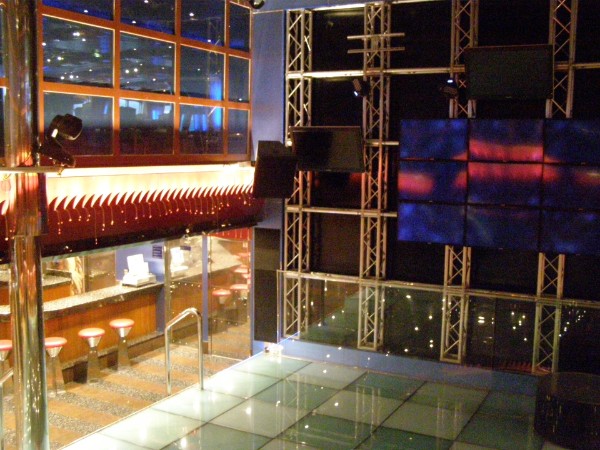
A little bit hidden next to the discoteque is the ships small but kinda charming chapel, shown below.
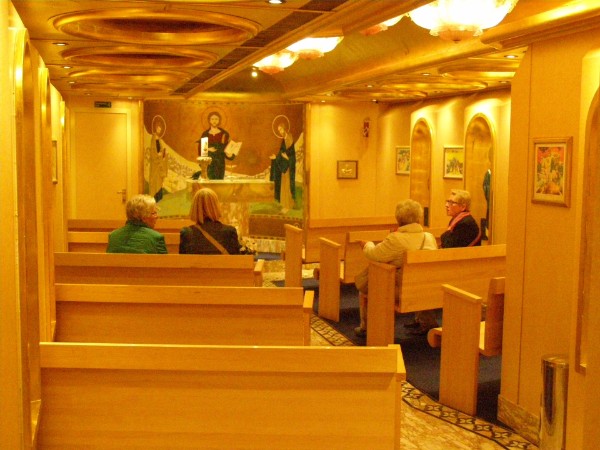
Further forward is also the ships library, named for the Galileo Galilei, that was built in 1963 for Lloyd Triestino. She sank as the cruiseship Sun Vista in 1999 within the Strait Of Malacca and is more-over known as the ship that started the services of Celebrity Cruises as their Meridian in 1990. One other ship that was built for Lloyd Triestino in the 1950's as Victoria, is also pictured at Castles Of The Seas under the name Anastasis. She was scrapped in 2003, as the last former Italian liner in excistance.
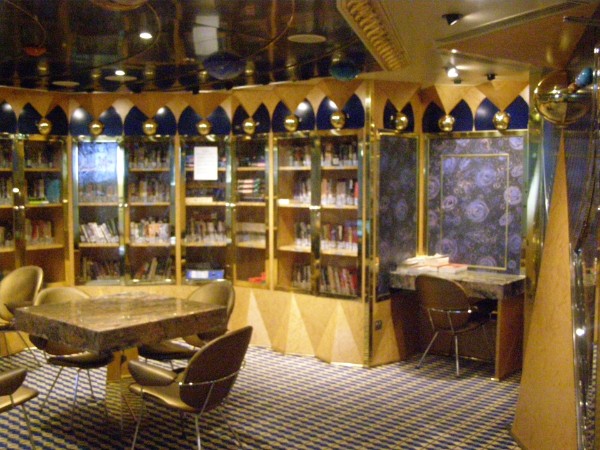
From Santos Deck (4), we now make a huge jump up to Napoli Deck (9), where the Lido Oceania 1932 (we spoke about that one already) is the central hub. This is the main pool aboard, surrounded by many sunloungers on the stepped-up decks towards the bow. Here, there is no sliding roof and with the weather being bad at Amsterdam this second of june 2015 I did not stay long. Cruiseships and sundecks are truly awesome, but in bad weather those sundecks become no-mans land with slippery wet floors, wet chairs and emptiness everywhere. Still I wanted to show it here, just imagine it full with happy people, cocktails and sunrays. As Costa Fortuna nowadays can be called a reletively older ship in the fleet (she was built in 2002, already 13 years ago and only Costa Victoria and Costa Atlantica are older units in the main fleet) there are no aquaparks or exciting features like giant moviescreens here. But yes, there is a Costa yellow and blue waterslide, but here it is called the Lido Barcellona, because it is one deck up at Barcellona Deck (10).
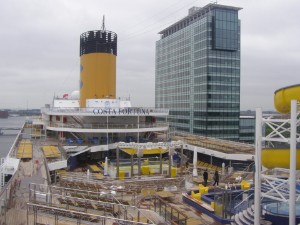 | | 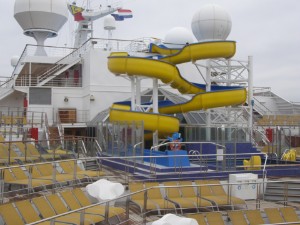 |
| | |
Fastly moving inside, we come to the informal Ristorante Buffet Cristoforo Colombo 1954, the ships lido restaurant. it is quite large but nicely decorated with nautical maps, historic maps and globes. Of course, there are also several buffets to choose from when swimming or sports made you hungry enough for an informal bite.
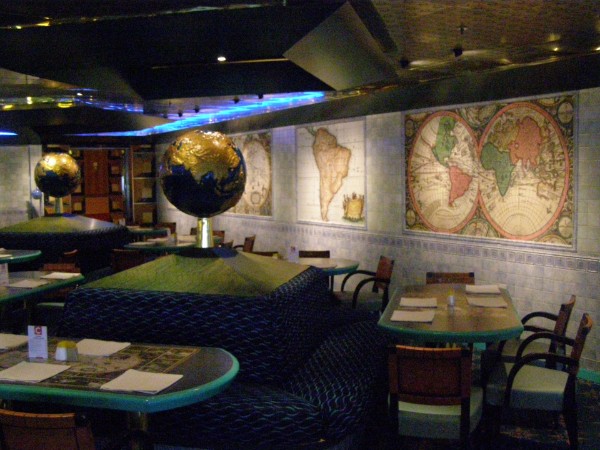
At the other side of the lido restaurant is the Lido Cristoforo Colombo 1954, overlooking the ships stern and this time, it has a retractable glass roof. A statue of a scaresly dressed young lady looking for a swim is close-by, surrounded by a small fountain. Here are also two bars, flanking the pool.
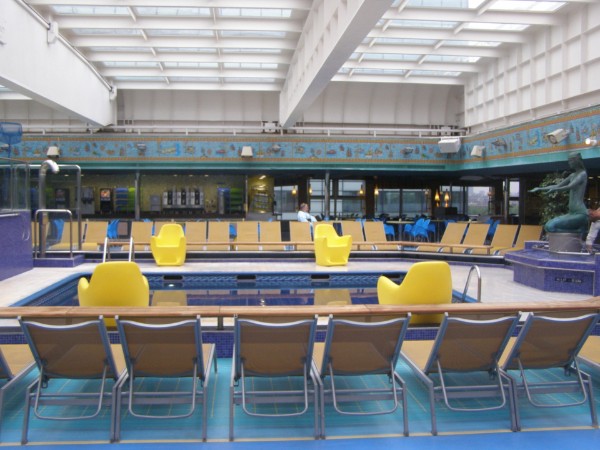
Many decorations aboard are of course inspired by the old Italian liners Several murals are based on advertisements from that time and also paintings o former liners are everywhere to be seen. Below, I give a small selection that gives an indication about what to find aboard at the walls.
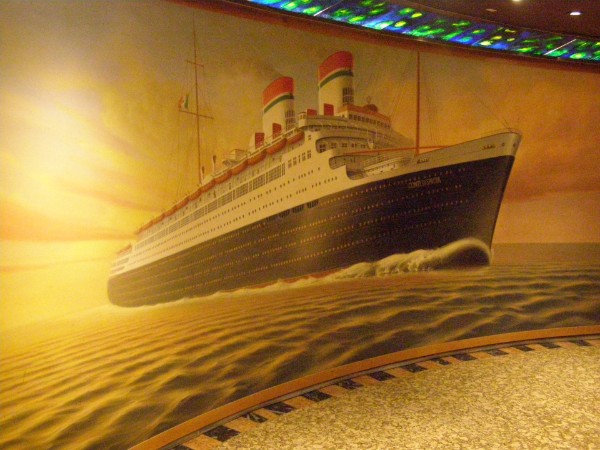
And last but not least, below I picture one of the ships cabins, number 1342 at Rio de Janeiro Deck (1). It is an standard outside cabin (not meaning it is outside the ship, of course) and almost all cabins aboard do have more-or-less the same dimensions. This one does have a connecting door to the cabin nextdoor, so families with children are able to have some space for themselves but also stay close-by eachother. Or maybe, when you book this cabin next to a beautifull Italian lady, you can try out your own version of Italian charm.
